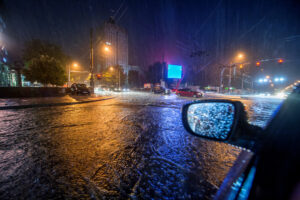
By Alexandru Chiriac at Shutterstock
We have witnessed major floods across the United States over the years. With the rise in extreme hurricanes along the coasts, entire communities are succumbing to flood damage. In Louisiana, Texas, California, and Florida, there are whole communities actively preparing for rising flood waters throughout the year. Severe storms and heavy rains also frequently bring about flash flooding in cities across the country. If you live in an area prone to flooding, you should take steps to prepare now. By being prepared early, you can reduce your risk of property damage and injury. If you do suffer from flood damage, call your local restoration company to begin the flood damage restoration process.
Preparing for Flood Damage
If you know you live in an area prone to flooding, such as zone AE on FEMA’s flood map, then it pays to be prepared early. The water from a flood, with such immense force and volume, can destroy your home or foundation within a matter of hours.
Here is how to prepare:
- Invest in a sump pump with a backup power supply. A sump pump – usually battery operated – will help remove excess water from the lowest point in your home. The unit is generally installed in a basement and runs on a 12-volt battery.
- Hire an experienced electrician to raise your electrical components throughout the house, including switches, sockets, and circuit breakers. You want these components at least 12” above the projected flood elevation of your home. This will protect your expensive electrical system and prevent electrocution.
- Now is the time to waterproof your basement or entrances to the lowest point of your home. You can waterproof this area be ensuring your gutters and storm drains are clear, diverting water from window wells and entrances, and investing in a sump pump as mentioned above.
- Acquire a disaster preparedness kit and keep it up-to-date. You’ll want to secure enough supplies for your entire family and pets, including up to three days’ worth of dry food and water, medical supplies, flotation devices, life vests, a working, battery-operated radio, and extra batteries.
- Throughout the flood conditions, you need to remain informed. If you have a battery-operated radio, tune into your local weather station or the national weather association for flood updates. If your city issues an evacuation notice, you need to be prepared with an escape route and your supplies.
Flood Insurance
According to FEMA, if you live in an area prone to flooding, it’s a smart idea to invest in flood insurance. Sure, it’s an extra cost on top of your homeowners insurance, however, it’s important to note that your average homeowners insurance policy does not cover flooding. You would be out of pocket for the entire cost of repairs and restoration work. Thankfully, flood insurance is available to anyone through the National Flood Insurance Program. You can find public and private quotes by calling the NFIP.
For 24-hour flood recovery services, contact your local Restoration 1. We’ll arrive within an hour and begin mitigating damage and removing standing water immediately!

